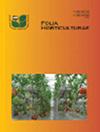有毒植物叶表皮和毛状体微形态多样性及其分类意义
IF 1.8
4区 农林科学
Q2 HORTICULTURE
引用次数: 1
摘要
摘要扫描显微成像技术的改进在分析叶片标本的超微结构方面发挥了重要作用,已成为一种有价值的微形态研究工具。使用显微镜技术,例如光学显微照片(LMs)和扫描显微照片(SEM),报道了25种选定的有毒植物的叶表皮解剖结构,特别是气孔和毛状体。本研究旨在调查所研究物种的微形态,这有助于鉴定有毒植物。植物被收集、压制、干燥、鉴定,然后进行显微镜研究分析。为了制作显微镜载玻片,在试管中取1或2片叶子,在30%的硝酸和70%的乳酸中浸泡几分钟,然后放在培养皿上分离表皮。研究了近轴和远轴表面的许多定量和定性的叶片解剖特征,包括表皮细胞形状、气孔大小、辅助细胞大小、虎丘壁的模式、气孔复合体的形态和毛状体的多样性。少数被考虑的物种有细胞异常和不等细胞的气孔;少数物种具有细胞旁气孔,如蓖麻、大戟、毛须和高梁;在所研究的分类群中,只有肉苁蓉具有环细胞气孔。被分析物种的表皮细胞是不规则的,而一些表现出多边形、波浪形、四方形和细长的细胞形态。总的来说,这项研究强调了叶片微形态分析作为识别潜在有毒植物的宝贵资源的重要性,并证明了其对维护公共福利的贡献,从而有利于公众健康和安全。本文章由计算机程序翻译,如有差异,请以英文原文为准。
Foliar epidermal and trichome micromorphological diversity among poisonous plants and their taxonomic significance
ABSTRACT Scanning microscopic imaging has become a valuable research tool in micromorphology with improved techniques playing an important role in analysing the ultrastructure of leaf specimens. The foliar epidermal anatomy of 25 selected poisonous plants with special emphasis on stomata and trichomes was reported using microscopic techniques, for instance, light micrographs (LMs) and scanning micrographs (SEMs). This study aimed to investigate micromorphologies of studied species that are helpful for the identification of poisonous plants. Plants were collected, pressed, dried, identified and then analysed for microscopic study. For making microscopic slides, 1 or 2 leaves were taken in a test tube and dipped in 30% nitric acid and 70% lactic acid for few minutes, and then placed on petri plates for separating the epidermis. Numerous quantitative and qualitative foliar anatomical features of adaxial and abaxial surfaces, including epidermal cell shapes, stomata size, subsidiary cell size, the pattern of the anticlinal wall, the morphology of the stomatal complex and trichome diversity, were examined. A small number of the considered species had anomocytic and anisocytic stomata; a few species had paracytic stomata, for instance, Ricinus communis, Euphorbia royleana, Buxus pilosula and Sorghum halepense; and only Ipomoea carnea had cyclocytic stomata in the studied taxa. The epidermal cells of the analysed species were irregular, while some exhibited polygonal, wavy, tetragonal and elongated cell morphologies. Overall, this study emphasises the significance of foliar micromorphology analysis as a valuable resource for identifying potentially poisonous plants and demonstrates its contribution to maintaining public welfare, thereby benefitting public health and safety.
求助全文
通过发布文献求助,成功后即可免费获取论文全文。
去求助
来源期刊

Folia Horticulturae
Agricultural and Biological Sciences-Horticulture
CiteScore
3.40
自引率
0.00%
发文量
13
审稿时长
16 weeks
期刊介绍:
Folia Horticulturae is an international, scientific journal published in English. It covers a broad research spectrum of aspects related to horticultural science that are of interest to a wide scientific community and have an impact on progress in both basic and applied research carried out with the use of horticultural crops and their products. The journal’s aim is to disseminate recent findings and serve as a forum for presenting views as well as for discussing important problems and prospects of modern horticulture, particularly in relation to sustainable production of high yield and quality of horticultural products, including their impact on human health.
 求助内容:
求助内容: 应助结果提醒方式:
应助结果提醒方式:


